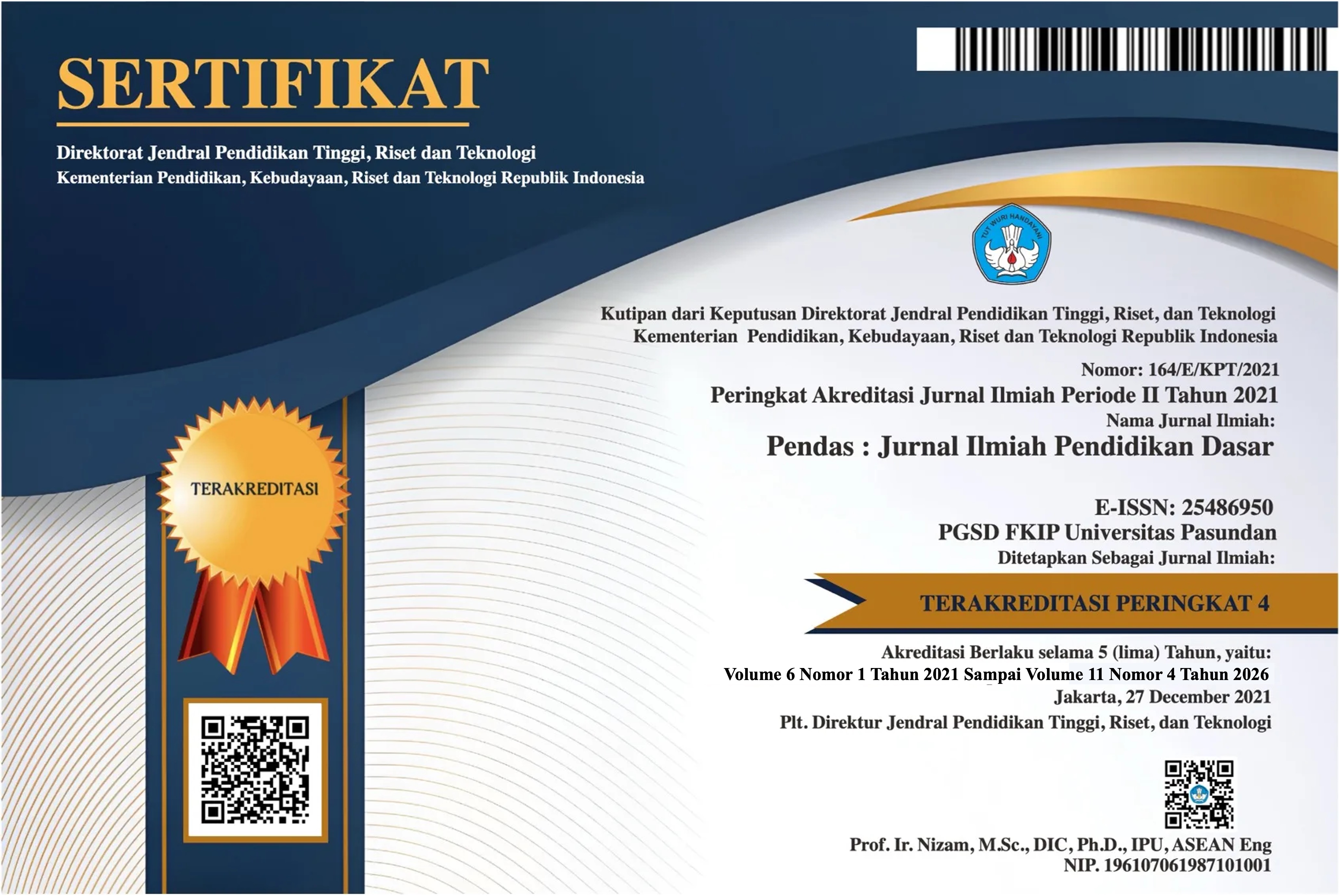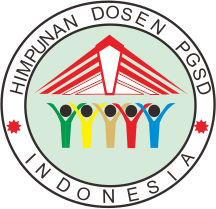THE RELATIONSHIP BETWEEN SELF-EFFICACY AND SPEAKING ANXIETY AMONG PGSD STUDENTS IN ASSISTING ENGLISH SPEAKING LESSONS AT THE ELEMENTARY LEVEL
DOI:
https://doi.org/10.23969/jp.v10i04.35325Keywords:
self-efficacy, speaking anxiety, PGSD students, pre-service teacher readinessAbstract
This study investigated the relationship between self-efficacy and speaking anxiety among students of the Primary School Teacher Education (PGSD) program in assisting English speaking lessons at the elementary level. Employing a quantitative correlational design, data were collected from 83 students of the 2023 PGSD cohort at Universitas Negeri Makassar, selected through simple random sampling using Slovin’s formula. Two validated instruments were used: the Self-Efficacy Scale and the Speaking Anxiety Scale, both showing good reliability (α = .82 and .79). Data analysis involved descriptive statistics, Pearson’s correlation, and Kendall’s tau-b. The findings revealed a significant negative correlation between self-efficacy and speaking anxiety (r = –.290, p = .008; τ = –.252, p = .002), indicating that students with higher self-efficacy tended to experience lower levels of speaking anxiety. These results emphasize the critical role of affective factors in pre-service teacher preparation, particularly within structured programs such as Asistensi Mengajar di Satuan Pendidikan (AMSD), Pengenalan Lapangan Persekolahan (PLP) 1, and PLP 2, where PGSD students serve as teaching assistants. The study suggests that pedagogical strategies such as microteaching, peer collaboration, and reflective practice may enhance self-efficacy and reduce speaking anxiety, thereby improving pre-service teachers’ readiness to support English speaking instruction at the elementary level.
Downloads
References
Alrashdi, F. (2024). Challenges to effective English teaching in primary schools in Buraydah, Saudi Arabia: Perspectives of English teachers. Journal of Education and Learning, 13(5), 59–71. https://doi.org/10.5539/jel.v13n5p59
Ansari, M. S. (2015). Anxiety in English language learning: A case study of English language learners in Saudi Arabia. International Journal of Education and Literacy Studies, 3(1), 72–81. https://doi.org/10.7575/aiac.ijels.v.3n.1p.72
Aprilia, L., & Wahyudin, A. Y. (2020). Speaking anxiety in online English language classes. Journal of English Language Studies, 5(2), 229–238. https://files.eric.ed.gov/fulltext/EJ1276370.pdf
Arifin, M. B., Sundari, H., & Syakur, A. (2024). Investigating pre-service EFL teachers’ strategies to overcome speaking anxiety: A mixed-methods study. Studies in English Language and Education, 11(1), 90–110. https://doi.org/10.24815/siele.v11i1.29363
Asan, H., & Çeliktürk-Sezgin, Z. (2018). Effects of the educational games on primary school students’ speaking skills and speaking anxiety. Journal of Education and Training Studies, 6(6), 1–8. https://doi.org/10.11114/jets.v6i6.3188
Bandura, A. (1977). Self-efficacy: Toward a unifying theory of behavioral change. Psychological Review, 84(2), 191–215. https://doi.org/10.1037/0033-295X.84.2.191
Cirocki, A., Anam, S., & Ramadhan, S. (2025). Indonesian pre-service EFL teachers’ readiness for developing learner autonomy. Journal of Language and Education, 11(1), 1–19.
Creswell, J. W. (2014). Research design: Qualitative, quantitative, and mixed methods approaches (4th ed.). Sage.
Fu, Y., & Wang, J. (2021). Assessing mainstream pre-service teachers’ self-efficacy to teach English language learners. International Journal of Instruction, 14(3), 153–174. https://doi.org/10.29333/iji.2021.1439a
Kalimova, L., Kalimov, R., & Shaimardanova, M. (2022). A study of pre-service teachers’ readiness for integrated learning in primary school. European Journal of Contemporary Education, 11(4), 1198–1211. https://doi.org/10.18844/cjes.v17i5.7333
Karacaoğlu, Ö. C. (2025). Basic skills of 21st century teachers. Journal of Education and Learning, 14(2), 12–19. https://eric.ed.gov/?id=EJ1469757
Kemendikbudristek. (2022). Kurikulum Merdeka untuk SD: Panduan implementasi. [Dokumen resmi pemerintah RI].
Kırbaş, A., & Bulut, M. (2024). Examining the 21st century skills teaching levels of teacher candidates. International Journal of Technology in Education, 7(3), 434–455. https://doi.org/10.46328/ijte.800
Kralova, Z., & Tirpakova, A. (2019). Nonnative EFL teachers’ speaking anxiety: Post-communist country context. Education and Self Development, 14(3), 88–99. https://doi.org/10.26907/esd14.3.08
Özdil, Ş., & Duran, E. (2023). Development of persuasive speaking skills rubrics. International Journal of Education and Literacy Studies, 11(1), 59–67. https://doi.org/10.7575/aiac.ijels.v.11n.1p.59
Putri, N. L. V. W., & Mangunsong, F. M. (2024). Empowering educators: Exploring teacher understanding and implementation of differentiated instruction in Indonesian primary schools. Mimbar Sekolah Dasar, 11(3), 542–556. https://doi.org/10.53400/mimbar-sd.v11i3.75215
Šafranj, J. F., Gak, D. M., & Bulatović, V. V. (2022). Anxiety and self-efficacy in ESP learning: Effects on academic success. Research in Pedagogy, 12(2), 447–460. https://doi.org/10.5937/IstrPed2202447S
Skourdoumbis, A., & Madkur, A. (2020). Symbolic capital and the problem of navigating English language teacher practice: The case of Indonesian pesantren. TESOL in Context, 29(2), 15–34. https://eric.ed.gov/?id=EJ1311416
Tutyandari, C. (2022). Pre-service teachers’ sense of preparedness for teaching: A study from Indonesia. TEFLIN Journal, 33(2), 388–405. http://dx.doi.org/10.15639/teflinjournal.v33i2/367-385
University of Sydney. (2023). Supporting self-efficacy development from primary school to the professions: A guide for educators. Educational Innovation, University of Sydney.
Waluyo, B., Zahabi, A., & Panmei, B. (2025). Examining the correlates and components of English test anxiety in EFL students: A quantitative study. MEXTESOL Journal, 49(1), 1–14. https://www.mextesol.net/journal/index.php?page=journal&id_article=27415
Downloads
Published
Issue
Section
License
Copyright (c) 2025 Pendas : Jurnal Ilmiah Pendidikan Dasar

This work is licensed under a Creative Commons Attribution 4.0 International License.


















